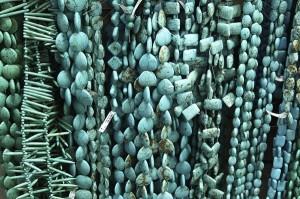A Bit o’History
The tradition of using turquoise in jewelry is ancient and found around the world. The Mesopotamians used turquoise beads as early as 5000BC. The Egyptians used it to adorn Tutankhamen’s golden throne. Empress Maria Louise of France replaced the emeralds in a diadem, set with 1006 diamond, with turquoise. The Mesoamericans used turquoise to adorn their ceremonial masks from the fourth to the seventh centuries AD. The Pueblo Indians have used turquoise beads since 1000AD. They also introduced the Navajo to silver smithing in 1853, then the Zuni learned silver smithing in turn from the Navajo.
What does it look like?
 Turquoise comes in shades of blue and green often with a black or brown matrix running through it and is usually found as a byproduct of copper mining. The finest blue turquoise is believed to come from Persia (Iran) and before World War I it was Persia’s number one export. It is so lovely, I have never seen Persian turquoise set in anything but gold.
Turquoise comes in shades of blue and green often with a black or brown matrix running through it and is usually found as a byproduct of copper mining. The finest blue turquoise is believed to come from Persia (Iran) and before World War I it was Persia’s number one export. It is so lovely, I have never seen Persian turquoise set in anything but gold.
I am most familiar with the turquoise that comes from the American Southwest, Arizona and New Mexico. Most of these stones are set by the Native American artisans, whose silversmith work I have admired for years. When I visit Santa Fe and Tucson I always try to bring home a small piece and take inspiration from their work.
The blue turquoise used in many of the Native American jewelery designs is hard to get since a large copper strip mine near Tucson closed in 1974. Many of the turquoise I use are from China. Using Chinese stones helps me to keep my turquoise pieces in a price range that many women can afford.
Care and Handling of Turquoise
Turquoise is only a 5-6 on the Mohs’ Harness Scale. For this reason, with few exceptions, all of the turquoise I use are stabilized to harden the stone and make it more wearable. In my shop I make it a practice to indicate where treatment has been used and where the stone is natural.
When cleaning your turquoise you should avoid steam, ultra sound, hot water and household cleansers.



